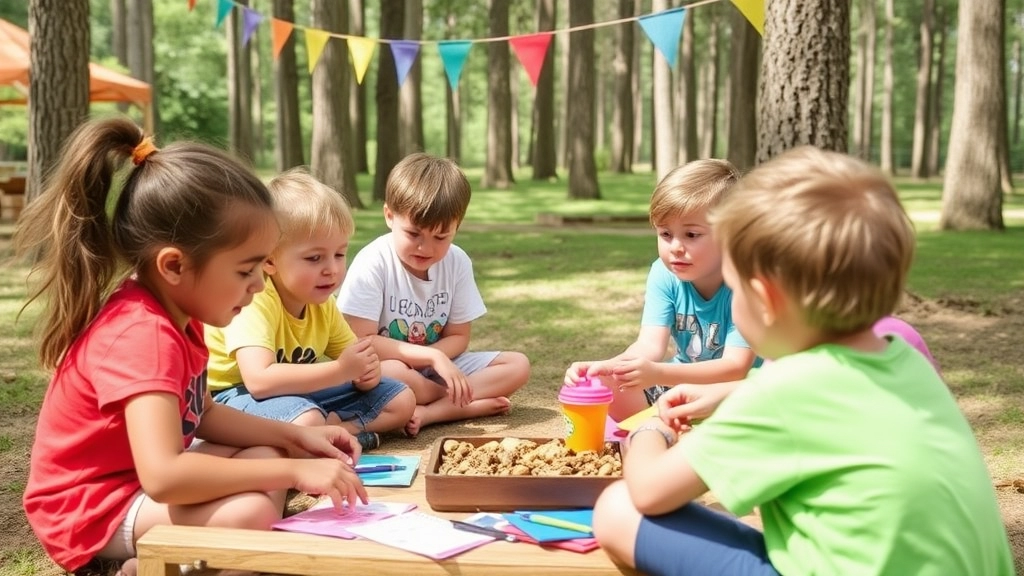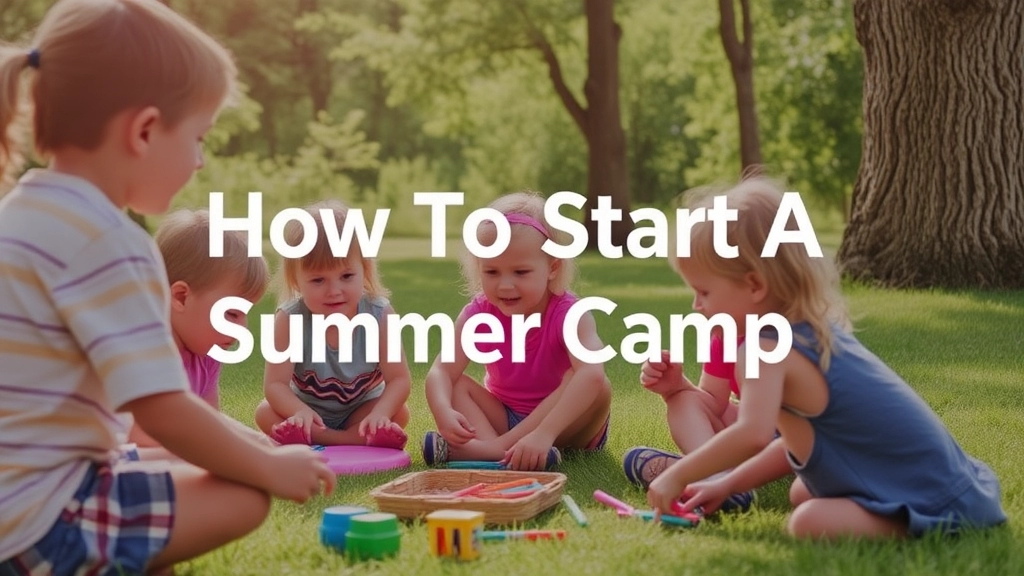Starting a Summer Camp
Embarking on the journey of starting a summer camp is both exhilarating and challenging. From meticulous research and planning to choosing the perfect theme and activities, each step is crucial in crafting an unforgettable experience. With the right strategy, your camp can become a cherished summer tradition.
What You’ll Discover
In this guide, you’ll discover how to:
- Select an ideal location
- Develop a robust financial plan
- Navigate the maze of permits and licenses
- Hire passionate staff
- Implement safety protocols
- Create a buzz with effective marketing
Transform Your Vision
Dive in and transform your vision into a thriving summer camp adventure!
Research and Planning Your Summer Camp
Alright, folks, let’s dive into the nitty-gritty of research and planning your summer camp. You’re probably thinking, “How do I even start?” Well, you’re not alone. Many people have the same question, and I’m here to break it down for you.
Why Research and Planning Matter
You can’t just wing a summer camp. If you do, it’ll be a disaster. Trust me. Here’s why research and planning are crucial:
- Understanding Your Audience: Who are you targeting? Kids? Teens? Families? Knowing this helps you tailor everything from activities to marketing.
- Legal Requirements: You don’t want to get shut down because you missed a permit or license.
- Financial Planning: Without a budget, you’re setting yourself up for unexpected costs and financial stress.
Steps to Effective Research and Planning
- Identify Your Goals:
- What do you want to achieve with this camp?
- Are you looking to make a profit, or is it more about community engagement?
- Market Research:
- Competitor Analysis: Check out what other camps are doing. What works for them? What doesn’t?
- Surveys and Feedback: Ask potential campers and parents what they want. Use online surveys or social media polls.
- Legal and Safety Requirements:
- Permits and Licenses: Look into local regulations. You might need specific permits for activities like swimming or hiking.
- Safety Protocols: Research industry standards for safety. This includes first aid, emergency procedures, and staff training.
- Financial Planning:
- Budgeting: List all potential costsâlocation fees, staff salaries, equipment, and marketing.
- Funding: Are you self-funding, or will you seek sponsorships and grants?
Real Stories and Examples
When I first started planning a summer camp, I had no idea how much went into it. I thought, “How hard could it be?” Well, I quickly learned that without a solid plan, things fall apart fast. I once forgot to account for transportation costs, and it nearly blew our budget. Lesson learned: always overestimate your expenses.
Key Takeaways
- Research is Your Best Friend: Don’t skip this step. It’s the backbone of your camp.
- Plan for the Unexpected: Always have a contingency plan. Things will go wrong; it’s how you handle them that counts.
- Engage Your Audience: The more you know about your campers, the better you can serve them.
So, if you’re serious about planning your summer camp, start with thorough research. It’s the foundation that will support everything else you do. For more insights, check out our Ultimate Summer Camp Calendar Guide and learn about the Summer Camp Commissary Setup to ensure a successful camp experience.
Choosing a Camp Theme and Activities

Ever wondered what makes a summer camp unforgettable?
It’s all about the camp theme and activities.
Picking the right theme can make or break your camp.
So, how do you choose?
Start with these questions:
- What’s the age group of your campers?
- What are their interests?
- Do you want an educational angle or just pure fun?
Why Themes Matter
Themes set the tone.
They create excitement.
Think about it. Would you rather go to a “Generic Summer Camp” or a “Pirate Adventure Camp”?
Exactly.
Popular Camp Themes
Here are some winning ideas:
- Nature Explorers: Perfect for outdoor lovers. Activities could include hiking, bird watching, and nature crafts.
- Science and Space: For the curious minds. Think rocket building, stargazing, and science experiments.
- Sports Mania: For the active bunch. Football, basketball, swimming – you name it.
- Arts and Crafts: For the creative souls. Painting, pottery, and DIY projects.
Activities to Match Your Theme
Once you’ve nailed down your theme, it’s time to plan activities.
Here’s how:
- Brainstorm: Get your team together. Jot down every idea, no matter how crazy.
- Categorise: Split them into physical, mental, and creative activities.
- Match: Align activities with your theme.
Real-Life Example
Last year, we ran a “Survivor Camp”.
Kids loved it.
We had obstacle courses, team challenges, and survival skills workshops.
By the end of the week, they were begging for more.
Pro Tips
- Mix it up: Balance between high-energy and chill activities.
- Get feedback: Ask past campers what they enjoyed.
- Stay flexible: Be ready to tweak activities based on camper interest and weather conditions.
Selecting the Ideal Location
Alright, let’s talk about one of the biggies: selecting the ideal location for your summer camp. This isn’t just about picking a pretty spot; it’s about finding a place that ticks all the boxes for your campers, staff, and activities. So, let’s break it down.
What Are You Looking For?
First up, ask yourself these questions:
- What type of environment suits your camp theme? A forest, a beach, or maybe an urban setting?
- How accessible is it? Think about parents dropping off kids, staff commuting, and emergency access.
- What facilities are available? Are there cabins, kitchens, bathrooms, and activity spaces?
Must-Have Features
Here are some non-negotiables:
- Safety: The location must be safe. Check for any potential hazards like unstable terrain, wildlife risks, or water bodies.
- Space: Ensure there’s enough room for all planned activities and that campers won’t feel cramped.
- Amenities: Basic amenities like clean water, electricity, and restrooms are a must.
Location Types
Different types of locations offer different perks. Here’s a quick rundown:
- Campgrounds: Great for a rustic experience. Often come with built-in facilities like fire pits and picnic tables.
- Schools/Colleges: These can be ideal for day camps. They have classrooms, sports facilities, and often, dining halls.
- Private Properties: If you have the budget, renting a private property can give you more control over the environment.
Real-Life Example
Let me share a story. A friend of mine once chose a location purely based on its picturesque views. Sounds great, right? But they overlooked the fact that it was a two-hour drive from the nearest town. Parents weren’t thrilled about the commute, and getting supplies was a nightmare. So, always balance beauty with practicality.
Practical Tips
- Visit Multiple Sites: Don’t settle for the first place you see. Visit multiple locations and compare.
- Check Reviews: Look for reviews or testimonials from other camp organisers who have used the site.
- Talk to Locals: They can provide insights you might not get from a brochure or website.
Budget Considerations
Of course, the perfect location needs to fit your budget. Here’s how to manage that:
- Negotiate: Many locations are open to negotiation, especially if you’re booking for an extended period.
- Off-Peak Times: Consider running your camp during off-peak times to get a better rate.
- In-Kind Sponsorships: Sometimes local businesses might offer their property at a discount in exchange for sponsorship opportunities.
For more insights on finding the ideal camp location, check out our City of Milpitas Summer Camp Guide or explore Wooded Area Summer Camps: Benefits and Activities.
Developing a Budget and Financial Plan

Alright, let’s talk money.
How much is this summer camp going to cost you?
And more importantly, how do you make sure you don’t run out of cash halfway through?
These are the real questions you need answers to.
Why a Budget Matters
Budgeting is your best friend.
Without a solid financial plan, you’re flying blind.
You need to know where every pound is going.
Steps to Create a Budget
-
List Out Expenses:
- Location: Rent, utilities, maintenance.
- Staff Salaries: Pay rates, benefits, training costs.
- Supplies: Equipment, art supplies, sports gear.
- Food: Meals, snacks, dietary needs.
- Marketing: Ads, flyers, social media campaigns.
- Permits and Licenses: Legal stuff you can’t skip.
- Insurance: Liability, health, and property.
-
Estimate Income:
- Camper Fees: How much are you charging?
- Sponsorships: Local businesses, community grants.
- Fundraising: Events, donations, online campaigns.
-
Balance It Out:
- Make sure your income covers your expenses.
- Always have a bit extra for emergencies.
Tools to Help You Budget
- Spreadsheets: Excel or Google Sheets.
- Budgeting Apps: Mint, YNAB.
- Accounting Software: QuickBooks, Xero.
Real-Life Example
When we first started our summer camp, we underestimated the cost of supplies.
Halfway through, we had to scramble for more funds.
Lesson learned: always overestimate your expenses.
Better to have extra cash than to be short.
Financial Plan
A financial plan isn’t just about budgeting.
It’s about long-term sustainability.
- Cash Flow Management: Know when money is coming in and going out.
- Savings: Set aside a portion for future camps or unexpected costs.
- Investment: If you have extra funds, consider investing in better equipment or facilities.
Next Steps
Ready to dive into the nitty-gritty of camp finances?
Check out our guide on Obtaining Necessary Permits and Licenses to ensure you’re legally covered.
And if you’re looking for tips on Hiring Qualified Staff and Volunteers, we’ve got you covered there too.
Obtaining Necessary Permits and Licenses
Alright, let’s get real. You’ve got this awesome idea for a summer camp, but you’re probably wondering, âDo I need permits and licenses for this?â The short answer is: absolutely. But don’t sweat it. Let’s break it down into bite-sized pieces so you can tackle it like a pro.
Why You Need Permits and Licenses
First off, you need to know why permits and licenses are a big deal. Think about it like this: You wouldn’t want to run into legal trouble just because you skipped a few steps, right? Plus, having all the necessary paperwork shows parents you’re legit and serious about their kids’ safety.
Types of Permits and Licenses
Here’s the lowdown on what you might need:
- Business License: This is your basic permit to operate. It’s like a green light from the government saying, âYou’re good to go.â
- Health and Safety Permits: These ensure your camp meets all health and safety standards. Think food handling, first aid, and general camp safety.
- Zoning Permits: You need to make sure the location you’ve picked is zoned for a camp. No one wants to set up shop only to be told to pack it up.
- Activity-Specific Licenses: If you’re planning on activities like archery, swimming, or boating, you’ll need specific permits for those.
Steps to Obtain Permits and Licenses
Now, let’s get to the nitty-gritty. Here’s a step-by-step guide to make this process as smooth as possible:
- Research Local Regulations: Every region has its own rules. Start by checking with your local government or council to find out what’s required.
- Prepare Your Documents: Gather all necessary paperwork. This might include your business plan, safety protocols, and proof of insurance.
- Submit Applications: Fill out the required forms and submit them. Don’t forget to pay any associated fees.
- Inspections: Be prepared for inspections. Officials might want to check your location and facilities to ensure everything’s up to code.
- Follow-Up: Sometimes, you might need to make adjustments based on feedback. Stay on top of this to avoid delays.
Real-Life Example
When I first started my summer camp, I thought I could wing it with the permits. Big mistake. I ended up having to delay the opening because I didn’t have the right health and safety permits. Trust me, it’s worth getting it right the first time.
Tips for Smooth Sailing
- Stay Organised: Keep all your documents in one place. A simple folder can save you a lot of headaches.
- Ask for Help: Don’t be afraid to consult with a professional. Sometimes, spending a little on expert advice can save you a lot in the long run.
- Plan Ahead: Start this process early. Permits and licenses can take time to process, and you don’t want this to be the thing that holds you back.
If you’re looking for more detailed guidance on running a successful camp, check out our Ultimate Guide to Camp English Summer. And if you’re in the area, you might want to explore the Top Summer Camps in Greenville, SC to get some inspiration.
Hiring Qualified Staff and Volunteers

Alright, let’s get real.
Hiring the right staff and volunteers for your summer camp can make or break the experience.
Why?
Because these folks are the heart and soul of your camp.
They’re the ones who’ll be interacting with the kids, leading activities, and ensuring everyone has a blast.
So, how do we go about this?
Let’s dive in.
Understand What You Need
First off, figure out what roles you need to fill.
Do you need:
- Camp counsellors?
- Activity leaders?
- Lifeguards?
- Kitchen staff?
Make a list.
Look for Experience and Passion
You want people who:
- Have experience working with kids.
- Are passionate about your camp theme.
- Can handle the responsibilities.
Experience is great, but passion is a must.
Conduct Thorough Interviews
Don’t just skim through CVs.
Interview them.
Ask questions like:
- “How would you handle a homesick camper?”
- “What’s your favourite camp activity and why?”
- “Tell me about a time you dealt with an emergency.”
Get a feel for their personality and problem-solving skills.
Check References
Always.
Call up their previous employers or colleagues.
Ask about their reliability, attitude, and how they worked with kids.
Train Them Well
Once you’ve got your team, train them.
Cover:
- Safety protocols.
- Activity guidelines.
- Emergency procedures.
Make sure everyone’s on the same page.
Foster a Positive Culture
Create a supportive environment.
Encourage teamwork, open communication, and fun.
Happy staff = happy campers.
Use Stories and Examples
Think about that one camp counsellor who turned a shy kid into the life of the campfire.
Or the lifeguard who was always on the ball, making everyone feel safe.
These are the people you want on your team.
Creating a Marketing and Promotion Strategy
How do I get the word out about my summer camp? This is the question that keeps most of us up at night. You’ve got a killer camp planned, but if no one knows about it, it’s like throwing a party with no invites. So, let’s dig into a marketing and promotion strategy that’s going to fill those spots and make your camp the talk of the town.
Understanding Your Audience
First things first, who are you targeting? Are you aiming at parents looking for a fun and educational experience for their kids, or are you focusing on teens who want an adventure? Knowing your audience is key. Once you’ve nailed that down, everything else becomes easier.
Crafting Your Message
Now, let’s talk about your message. What makes your camp unique? Is it the activities, the location, the staff? Highlight what sets you apart. Make it clear, make it compelling, and make it unforgettable. Consider highlighting specific activities like top summer camp games and activities to attract interest.
Building an Online Presence
In today’s world, if you’re not online, you’re invisible. Here’s how to build a solid online presence:
- Website: Your website is your digital storefront. Make it clean, easy to navigate, and packed with all the info parents need. Use high-quality images and videos to showcase what your camp offers.
- Social Media: Get on platforms like Facebook, Instagram, and Twitter. Post regularly, share behind-the-scenes content, and engage with your audience. Use hashtags relevant to summer camps to increase your reach.
- Blog: Start a blog on your website. Write about camp activities, staff interviews, and tips for parents. This not only provides value but also helps with SEO. Check out our ultimate guide to kids’ summer camps for inspiration.
Email Marketing
Don’t underestimate the power of a good old email. Build an email list of interested parents and send out regular newsletters. Share updates, special offers, and countdowns to the camp start date. Make it personal and engaging.
Partnering with Local Businesses and Schools
Form partnerships with local businesses and schools. They can help spread the word through their networks. Offer to host a free workshop or an info session at schools. This builds trust and gets you in front of your target audience.
Leveraging Testimonials and Reviews
Word of mouth is gold. Encourage parents from previous years to leave reviews and testimonials. Share these on your website and social media. Real stories from real people build credibility and trust.
Running Promotions and Contests
Everyone loves a good deal. Run early bird promotions, sibling discounts, or referral bonuses. Host contests on social media where participants can win a free week at camp. This not only creates buzz but also drives engagement.
Using Paid Advertising
If you’ve got some budget, invest in paid advertising. Google Ads and Facebook Ads can be incredibly effective. Target your ads to reach parents in your area. Make sure your ads are eye-catching and have a clear call to action.
Tracking and Adjusting Your Strategy
Finally, keep track of what’s working and what’s not. Use tools like Google Analytics to monitor your website traffic. Pay attention to your social media engagement. Adjust your strategy based on what you learn.
Implementing Safety and Health Protocols

Worried about keeping your campers safe and healthy?
You’re not alone.
Safety and health protocols can make or break your summer camp experience.
So, let’s dive into it.
Why are Safety and Health Protocols Crucial?
First off, it’s about trust.
Parents need to know their kids are in good hands.
Campers need to feel safe to enjoy themselves.
And you need peace of mind knowing you’ve got it covered.
Here’s how to nail it.
Assess the Risks
Every camp is different.
Do you have water activities?
Are you in a wooded area?
Identify potential hazards:
- Water bodies (lakes, rivers, pools)
- Wildlife encounters
- Extreme weather conditions
- Allergies and medical conditions
Create a Comprehensive Plan
Emergency Procedures:
- Fire drills
- Evacuation routes
- First-aid stations
Health Protocols:
- Daily health checks
- Sanitization routines
- Food safety guidelines
Train Your Staff
Your staff is your frontline.
Make sure they know:
- CPR and first-aid
- How to handle emergencies
- Proper hygiene practices
Communicate with Parents
Transparency is key.
Share your protocols with parents:
- Detailed safety plans
- Health guidelines
- Emergency contact information
Regular Inspections
Don’t set it and forget it.
Regularly check:
- Equipment for wear and tear
- First-aid supplies
- Safety gear
Example: Handling Allergies
One of our campers had a severe nut allergy.
We created a nut-free zone in the dining area.
Staff were trained to use EpiPens.
Parents felt reassured, and the camper had a blast.
Enrolling Campers and Managing Registrations
Ever wondered how to get kids signed up for your summer camp without losing your mind? Yeah, I get it. The thought of managing camper registrations can be overwhelming. But don’t worry, I’ve got your back. Let’s break it down step-by-step so you can nail this part of your camp planning.
Why Is Camper Enrollment So Crucial?
Before we dive into the nitty-gritty, let’s get one thing straight: enrolling campers is the lifeblood of your summer camp. No campers, no camp. Simple as that. Plus, managing registrations efficiently can make or break the camper (and parent) experience.
The Basics of Camper Enrollment
First things first, you need a system. And by system, I mean something more sophisticated than a notepad and a pen. Here’s what you need to consider:
- Online Registration Platform: Use a reliable online registration system. This makes it easy for parents to sign up their kids and for you to keep track of everything. Think of platforms like CampMinder or ACTIVE Network.
- Clear Instructions: Make sure your registration process is straightforward. Parents are busy, so the easier you make it, the better.
- Early Bird Discounts: Offer incentives for early sign-ups. This not only boosts your numbers early on but also helps with cash flow.
Key Steps in Managing Registrations
Alright, now let’s break down the steps to manage camper registrations like a pro:
- Set Up Your Registration Form: Include all the necessary fieldsâcamper’s name, age, medical info, emergency contacts, and preferred activities. Keep it concise but comprehensive.
- Automate Confirmations and Reminders: Use your registration platform to send automatic confirmation emails and reminders. This saves you a ton of time and keeps parents in the loop.
- Track Payments: Make sure your system can handle payments securely. Track who’s paid and who hasn’t, and follow up as needed.
- Create a Waitlist: Camps can fill up fast. A waitlist ensures you don’t lose potential campers if spots open up.
- Data Management: Keep your data organised. Use spreadsheets or your registration platform’s reporting tools to keep track of all the details.
Handling Special Requests and Needs
Every camper is unique, and some might have special needs or requests. Here’s how to handle them:
- Medical Needs: Have a section in your registration form for parents to disclose any medical conditions. Make sure your staff is trained to handle these.
- Dietary Restrictions: Same goes for foodâknow who needs gluten-free, nut-free, or other special diets.
- Activity Preferences: Let campers choose their preferred activities. This makes their experience more enjoyable and personalised.
Real Talk: Common Challenges and How to Tackle Them
Let’s be real. Things don’t always go smoothly. Here are some common issues and how to deal with them:
- Last-Minute Cancellations: They happen. Have a clear cancellation policy in place and communicate it upfront.
- Overbooked Sessions: Use your waitlist wisely. If a spot opens up, fill it quickly.
- Payment Issues: Some parents might have trouble with payments. Offer multiple payment options and be flexible with payment plans if possible.
My Personal Experience: A Story to Illustrate
Alright, let me share a quick story. Last summer, we had a parent who was super late with registration. She was stressed out, and honestly, so were we. But because we had a solid system in place, we managed to get her kid signed up without a hitch. She was so relieved and grateful, and her kid had an amazing time at camp. That’s the power of a good registration system.
Further Reading
To dive deeper into the topic, check out our comprehensive guide on securing funding for summer camps. Additionally, if you’re looking to enhance the overall experience for your campers, our article on summer camp art activities offers some creative ideas and tips.
Organizing Camp Schedules and Logistics
Ever feel like organizing a summer camp schedule is like juggling flaming swords?
Yeah, it can be that tricky.
But don’t sweat it.
I’ve got you covered.
Why is Organizing Camp Schedules Important?
You want your campers to have a blast, right?
A well-organized schedule ensures that.
It keeps everything running smoothly.
No chaos, no confusion.
Just pure, unadulterated fun.
Start with the Basics
First things first.
You need to know what activities you’re offering.
Break it Down:
- Morning Activities: Think sports, arts and crafts, nature walks.
- Afternoon Fun: Swimming, team games, maybe a bit of drama.
- Evening Events: Campfires, talent shows, stargazing.
Create a Daily Template
Having a template is like having a roadmap.
It guides you.
Keeps you on track.
Here’s a simple example:
| Time | Activity |
|---|---|
| 08:00 – 09:00 | Breakfast |
| 09:00 – 12:00 | Morning Activities |
| 12:00 – 13:00 | Lunch |
| 13:00 – 15:00 | Afternoon Activities |
| 15:00 – 17:00 | Free Time |
| 17:00 – 18:00 | Dinner |
| 18:00 – 20:00 | Evening Events |
Flexibility is Key
Life happens.
Kids get tired.
Weather changes.
Be ready to adapt.
Logistics â The Backbone of Your Camp
Now, let’s talk logistics.
You need to think about:
- Transport: How are kids getting to and from activities?
- Meals: Dietary needs, allergies, and just plain picky eaters.
- Supplies: Do you have enough materials for activities?
Stories from the Trenches
I remember one summer, we had a sudden downpour.
Our outdoor games? Cancelled.
But because we had a backup plan, we moved indoors for a massive talent show.
Kids loved it.
Communication is Crucial
Keep everyone in the loop.
Parents, staff, even the campers.
Use notice boards, daily briefings, and good old-fashioned word of mouth.
For more tips on organizing camp schedules, check out our daily schedule guide and ensure your camp runs smoothly.
Looking for fun activities to fill those schedules? Explore our summer camp lesson plans for engaging and educational ideas.
FAQs on How to Start a Summer Camp
How do I choose a theme for my summer camp?
Choosing a theme involves understanding your campers’ age groups and interests. Decide whether you want an educational focus or just pure fun. Themes set the tone and create excitement, making your camp memorable.
What are some popular summer camp themes?
Popular themes include:
- Nature Explorers: Activities like hiking and bird watching.
- Science and Space: Rocket building and stargazing.
- Sports Mania: Football, basketball, swimming.
- Arts and Crafts: Painting, pottery, DIY projects.
How do I plan activities that match my camp theme?
Start by brainstorming ideas with your team. Categorize activities into physical, mental, and creative segments, and then align them with your chosen theme.
Why is budgeting important for a summer camp?
Budgeting ensures you have a clear financial plan, helping you avoid running out of funds halfway through the camp. It helps you track where every pound is going and ensures financial stability.
What steps should I take to create a budget for my camp?
Steps to create a budget include:
- List Out Expenses: Location, staff salaries, supplies, food, marketing, permits, and insurance.
- Estimate Income: Camper fees, sponsorships, and fundraising.
- Balance It Out: Ensure your income covers your expenses and have extra for emergencies.
How can I hire the right staff and volunteers?
Identify the roles you need to fill, such as camp counsellors, activity leaders, lifeguards, and kitchen staff. Look for individuals with experience working with kids and a passion for your camp theme. Conduct thorough interviews and check references.
What should be included in staff training?
Staff training should cover safety protocols, activity guidelines, and emergency procedures. Ensure everyone is on the same page to create a safe and enjoyable environment for campers.
Why are safety and health protocols crucial for a summer camp?
Safety and health protocols build trust with parents, make campers feel safe, and provide peace of mind for camp organizers. Proper protocols ensure a smooth and secure camp experience.
What are some key components of a comprehensive safety plan?
Key components include:
- Emergency Procedures: Fire drills, evacuation routes, first-aid stations.
- Health Protocols: Daily health checks, sanitization routines, food safety guidelines.
How should I communicate safety and health protocols to parents?
Transparency is key. Share detailed safety plans, health guidelines, and emergency contact information with parents to build trust and reassure them about their children’s safety.
How often should safety inspections be conducted?
Regular inspections are essential. Frequently check equipment for wear and tear, ensure first-aid supplies are stocked, and verify the condition of safety gear to maintain a safe environment.
References
-
Choosing the Right Theme for Your Camp
-
How to Create a Budget for Your Summer Camp
-
Hiring and Training Staff and Volunteers

